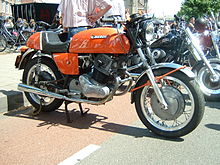Two-cylinder engine

A two-cylinder engine , or two-cylinder for short, or colloquially twin ( English for "twin"), is a reciprocating piston engine with two cylinders . Two-cylinder engines have two combustion chambers ; a double-piston engine with only one combustion chamber is considered a single-cylinder engine, even if it has two pistons in two cylinders. Two-cylinder engines can be in-line, boxer or V-engines.
history
The world's first two-cylinder engine was designed by the Russian engineer Ivan Polsunow in 1763 as a steam engine with an output of 1.3 kW (1.8 hp) . The machine came into regular use as early as 1766 when opening up new silver mines. For this invention, Polsunow was personally honored by Empress Catherine II and promoted to the rank of officer.
Gottlieb Daimler and Wilhelm Maybach developed the first two-cylinder engine as a V-engine in 1889 . Both connecting rods are hinged to a crank on the crankshaft .
Daimler and Maybach also created the first in- line engine , also as a two-cylinder, in 1892. A two-cylinder four-stroke in-line engine, also known as a parallel twin , either results in an even sequence of ignitions or, by linking the connecting rods to offset crankshafts, balances the inertial forces, albeit only moderately.
In 1897 Carl Benz developed the first two-cylinder boxer engine. The cylinders are arranged at an angle of 180 ° to one another and the connecting rods are hinged to the crankshaft on crankshafts offset by 180 °. Either both pistons move in opposite directions towards the crankshaft or in opposite directions away from the crankshaft.
Technology and dissemination
Multi-cylinder engines with the same cubic capacity can achieve a higher cubic capacity than single-cylinder engines due to the smaller individual cubic capacities . This results from the fact that the critical mean piston speed is only reached at higher speeds due to the smaller piston stroke, i.e. the engine can rotate higher without being damaged.
Depending on the design, the degree of uniformity is even better with two cylinders and the forces of inertia can be balanced without additional components such as balance shafts . In boxer engines, the inertial forces are completely balanced and the ignition sequence is even. Because the connecting rod is slightly offset to the side, there is a small moment of inertia around the vertical axis. In V2 engines, a cylinder angle of 90 ° is favorable for the degree of uniformity, because the kinetic energy oscillates back and forth between the pistons: when one piston is stationary at dead center , the other has its maximum speed. The mass forces are not balanced. In two-stroke in-line engines with 180 ° crank offset for the same ignition interval, the first-order inertia forces are balanced, and a moment of inertia arises around the transverse axis. Four-stroke parallel twins, which are built for the same ignition interval with a crank offset of 360 °, like a single-cylinder engine, have no compensation for the oscillating masses. They are suspended in soft rubber bearings or provided with two balance shafts.
While all three two-cylinder designs are used in motorcycles , two-cylinder V-engines are rare in automobiles .
Two-cylinder engines were popular in the early days of the automobile for driving voiturettes and light automobiles. The in-line twin cylinders from De Dion-Bouton , which can be found in several of its own series and were also bought in from other automobile manufacturers as built-in engines or reproduced under license, and from Clément-Bayard were more widespread . Two-cylinder engines were also up in the 1930s mainly in cyclecars and Threewheelern used, often Components motorcycle were constructed with another.
The most popular automobiles with two-cylinder in-line engines were the Fiat Nuova 500 and the Fiat 126 . The most popular automobile with a two-cylinder boxer engine is the Citroën 2CV . In the 1930s and up to the 1960s, two-cylinder two-stroke in-line engines were common in smaller cars ( DKW , Trabant , Saab , Lloyd , Glas , Subaru , Suzuki ). By far the most powerful two-cylinder cars were built by Panhard .
In 2009 the Tata Nano was presented with a two-cylinder in-line Otto engine. A corresponding two-cylinder diesel engine was also planned. In 2010 Fiat introduced a two-cylinder parallel twin in the Fiat 500 . The engine is marketed under the name Twin-Air and is also installed at Alfa Romeo Mito and Lancia Ypsilon . In the 2014 BMW i3 REx, a two-cylinder in-line engine increases the range. The range extender comes from the BMW C 650 GT or Sport scooter , but has only 28 kW (38 hp) instead of 44 kW (60 hp) in the i3.
Web links
literature
- Jacques Rousseau: Guide de l'Automobile française , Éditions Solar, Paris (1988); ISBN 2-263-01105-6 hardcover (French)
Individual evidence
- ^ Vehicle engine "V-Motor", 1889 . German museum. Retrieved January 16, 2010.
- ^ Susanne Eckelmann: Gottlieb Daimler. Tabular curriculum vitae in the LeMO ( DHM and HdG )
- ↑ The invention of the boxer engine: The Benz Contra engine was created in 1897. Retrieved on December 28, 2018 .
- ^ Rousseau: Guide de l'Automobile française , plate 101
- ^ Rousseau: Guide de l'Automobile française , plate 17
- ^ Rousseau: Guide de l'Automobile française , plate 18


